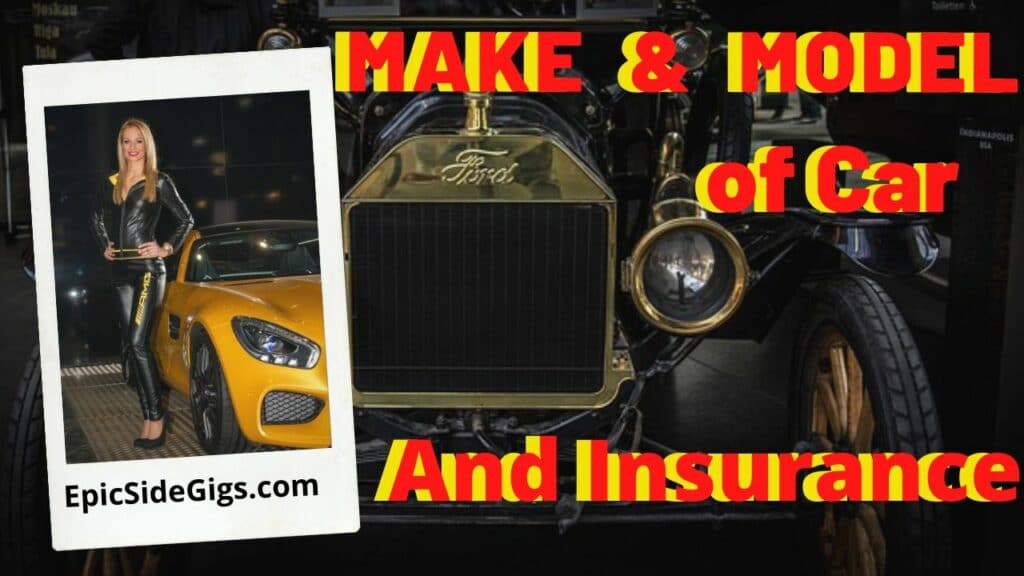Car Make and Model of Car – What Does that Mean?
A car’s make refers to the automaker – meaning the car’s manufacturer, like Honda or Ford. A car’s model is the specific type of vehicle produced by an automaker. Most automakers produce many different models. Honda produces Civic, Accord, Odyssey etc. Ford models include Fiesta, Mustang, Taurus… and so on. Make and model of car, as well as year, trim and accessories determine the purchase price of an automobile and greatly influence its insurance rates.
What is the Make of a Car?
The make of a car is the name of the manufacturer, the automaker. These include companies like Ford, Honda, and Chevrolet. Numerous manufacturers build cars around the world. In the U.S., consumers can choose from vehicles made by Japanese, Korean, and European car manufacturers. Some auto manufacturers produce two separate lines of vehicles. They segment a luxury line as distinct from their standard offering. Acura, for example, is the luxury line owned and produced by Honda. Despite being manufactured by Honda, they are distributed and sold at separate car dealerships.
Understanding Car Models
Car model, on the other hand, refers to the different types of cars produced under one car brand. Car models have distinct names within the brand to differentiate them from other vehicles in the lineup. Sometimes car models have specific proper names such as a GMC Yukon. Other times, the car model might just be a number or letter or a combination such as the Audi Q3. Some of the more famous car model names include the Mustang, Corvette, Prius, Explorer, and Beetle. Car model names are important to distinguish vehicles from one another. In some market segments, car makers release very similar vehicles under different model names. For example, the GMC Yukon and the Chevrolet Tahoe are very similar vehicles. Despite the different brands, both models are owned by the same company – General Motors.
Differences Between Car Models
Car model types is a more precise way to identify a vehicle besides just the car make. But, it is not precise enough in many applications. There are other factors to consider such as the model year and trim package of a car model. These factors come into play in terms of buying or selling, shopping for car insurance or even registering the vehicle. For example, various trims and model years of vehicles may have different options such as safety features, engine size, and transmission among others. This affects the value of the vehicle and can change the amount of premiums you will have to pay for car insurance.
Car Model Body Styles
The same car model might include different body styles under the same name. For example, a single passenger car model might offer a sedan, convertible, wagon and coupe version with the same name. An SUV crossover might also be referred to as a hatchback. The body style refers to the general shape and function of the vehicle. Identifying a Toyota sedan, for example, would narrow it down to cars with four doors. A Mitsubishi coupe is likely to be used to distinguish a two-door vehicle under that brand name. Here are some of the most common body style types:
- Coupe
- Sedan
- Hatchback
- Convertible
- Wagon
- SUV
The body style often dictates a vehicle’s general shape and the number of doors it has. Body style can also influence how it is set up mechanically—such as the engine, transmission and drivetrain. Often, body style is the most important distinction for a vehicle. This is because it has such a major impact on how the car looks and what a car is best used for.
Trim Levels For Car Models
Along with body styles, most car models also have at least a few different trim levels. For example, the 2019 Dodge Charger has the following trim level options: SXT, GT, R/T, SXT AWD, Scat Pack, and SRT Hellcat. Trim levels can be used in a tiered method where the lowest trim is the vehicle with the least amount of options while the luxury trim is at the top with the most options. Common trim levels are:
- Standard: no upgrades.
- Sport: upgraded engine performance and handling.
- Luxury: upgraded interior and smoother suspension.
However, sometimes trim levels are used to distinguish a vehicle’s different use category. In the example used above, the SRT Hellcat is a top-level sportscar trim. In another case, the Rubicon is a Jeep Wrangler trim designed more for off-roading. Some car makes logically distinguish trim levels while others have to be decoded. Mercedes-Benz is one of these that uses a combination of letters and numbers. The C 300 and the AMG C 43 are both C Class car models but are different trims.
Car Model Year
Car model years are another important way to distinguish vehicles and assess their value. Often, car makers completely redesign car models and the year is a meaningful way to know this. However, it’s important to remember that the model year does not necessarily indicate when the car was manufactured. For example, cars from the 2019 model year were available to purchase back in 2018. So if a redesign of a specific car model occurred for the 2019 model year, it was most likely manufactured in 2018. Source: autolist.com
What is a Vehicle Identification Number (VIN)?
Your car’s VIN should be printed on the driver’s side of the dashboard, near where the dash meets the windshield. It’s usually visible if you’re standing outside of the car looking in through the windshield. If you don’t see your VIN there, check on the inside of your driver’s side door. The 17-digit VIN code is made up of letters and numbers that can be found:
- Displayed on the driver’s side of the dashboard where it meets the windshield
- Inside of the driver’s side door
- Printed on your vehicle’s registration
Different Brands Made By The Same Carmaker
Some car manufacturers release very similar car models under different brand names. These carmakers usually have more than one brand name – even though they manufacture under both names. For example, an Acura MDX is manufactured by the Honda Motor Company. However, this vehicle is sold and distributed under the distinct brand – Acura. It would be incorrect to call an Acura MDX a Honda MDX. They are not interchangeable, so you can’t refer to a Honda Civic as an Acura Civic. In some cases, like with General Motors, the other brands are due to mergers with other companies in the past. GM acquired Buick and Cadillac in the past, and these are considered GM brands in the present. However, at one point they were their own brands. This is different from Toyota, which created Lexus for the luxury car market and Scion to target an economy market. Source: autolist.com
How To Determine Your Make and Model of Car
Car makes are identified by logos and by their names. You can always find both on your vehicle in one place or another. An carmaker’s emblem or name normally appears prominently on the front grille or rear of the car. The car model name or logo is also indicated somewhere on the vehicle – on the trunk lip, or a front quarter-panel. In the case that it’s not, it will be listed on the registration and in the owner’s manual.
The Outside of Your Vehicle
The back of your car should have the manufacturer’s name on one side and the model on the other side. Plus, the car maker’s logo is usually displayed in the center of the front and back of your car’s exterior.
The Owner’s Manual
The make and model of the vehicle is usually located on the cover of the owner’s manual, or within its first few pages.
Title or Registration
Your vehicle’s make and model is prominently displayed on both documents.
Use the Car’s Vehicle Identification Number (VIN)
You can enter your VIN into the National Highway Traffic Safety Administration’s VIN Decoder web page to reveal your car’s make, model, and other pertinent details.
How Do Make and Model of Car Impact Price?
The make and model of a car determines may factors, like the appearance, safety and performance. However, perhaps the most significant impact is on the value and price of a car. The make and model of a car not only impact its value but insurance premiums as well. The make of a car alone impacts a car’s price. For example, BMW, Audi, and Lexus are all vehicle makes associated with luxury, performance and higher costs to own. Honda, on the other hand, is a vehicle make known to be a bit more affordable and budget-friendly.
Similarly, the model of the car can go a long way toward determining the price as well. Take, for example, two different types of Toyota sedans. The 2020 suggested retail price of a Corolla is around $18,000, while the suggested price of a Camry is about $35,000. A Camry costs almost twice as much as a Corolla, even though both are sedans within the Toyota fleet. Additionally, the body style, accessories and trim package that you choose can also signigicantly affect the price of the vehicle. For instance, variations within the Honda Civic line tend to fluctuate by $1,000 or more. The more you upgrade the car, the more expensive it’s going to become.
Insurance Premiums
Vehicle upgrades affect your upfront costs, but they also impact your insurance rates and premiums. This is for a few reasons. For starters, insurance companies determine your rates based on the value of your car. A more expensive car will likely come with more expensive insurance premiums. This is because expensive cars are more expensive to repair or replace. Insurers also base rates based on how often other drivers have filed claims for a particular make and model. So, if you upgrade to a convertible or sport body style, your insurance rates will likely be higher than a standard sedan. Your insurance company finds these cars riskier because people tend to drive them more aggressively. Ultimately, there tend to be more insurance claims filed for the sportier models. You can lower your insurance premiums by instead opting for vehicles a bit less flashy or with better safety features.
So, the make and model of a vehicle influence your premiums when buying car insurance. Therefore, be sure to provide the entire model when requesting an insurance quote. This should nclude all letters, numbers, trim levels, engine size and even transmission type. You never want to pay insurance on a higher-priced model when you don’t have to. Here are some related factors that will affect your rates:
Factors that Cause You to Pay More:
- High Value Make and Model – The make and model has a high value with higher costs for comprehensive and collision coverages.
- Claims History – How many claims on average are filed for that specific make and model? More claims mean higher premiums.
- Safety Features – The vehicle is a sports model and does not contain advanced safety features.
Factors that Cause You to Pay Less:
- Safety Rating – Vehicle has a high safety rating from the National Highway Traffic Safety Administration
- Advanced Features – Advanced safety features are equipped on the vehicle
- Anti-theft Features – The make and model is equipped with a number of anti-theft features
Using the Toyota Camry as an example, the MSRP is more for the Hybrid LE than the LE. However, the Hybrid LE owner pays less for car insurance than the LE owner because the Hybrid LE has more advanced safety and collision prevention features.
Other Factors that Affect your Car Insurance Rates
Auto insurance companies also take into account many other factors when calculating car insurance rates. Ultimately, insurance companies want to limit risk. Before buying a vehicle, it’s a good idea to check how much it will cost to insure. Things that will influence your insurance premiums include:
- Your Driving Record,
- ZIP code – Your ZIP code also plays a large role in your rates. Insurance companies will set higher rates for areas with higher claims.
- Demographics of the owner
- Ages and Driving Record of other drivers of the vehicle and family members.
If an insurer finds that it pays out more claims for a specific make and model, it will consider that vehicle riskier. That translates into higher insurance rates on those types of vehicles. The reason could simply be that a certain make and model gets into more accidents or is stolen more than other vehicles. An insurer will also take into account safety features on vehicles and the cost of claims. A sports or luxury car that costs more to fix will cost more to insure than a standard pickup truck.
Your Car’s History Report – If your car was preowned, you can obtain its make and model by requesting a vehicle history report from your local Department of Motor Vehicles (DMV). You will need the vehicle’s title, VIN, and proof of identification. The car history report contains:
- A record of past ownership
- Vehicle’s title
- Odometer settings
- Existing liens on the vehicle
- Maintenance performed
How to Request an Auto Insurance Quote
When applying for an auto insurance quote, you need to provide the following information:
- Make, model, and year of your car, including its trim level designation and body style
- VIN
- Your age and gender
- Driver’s license number of anyone who will be listed on the policy
- Vehicle registration
- Driving history
- Credit history
Make and Model of Car – Final Words
Cars are identified by make and model. The make identifies which auto manufacturer built it. A car’s make refers to the carmaker or company that produced the car. Famous car makes include Cadillac, BMW, Toyota, Volkswagen, Ford, Honda, Peugeot, Hyundai-Kia, Nissan, Renault, Ferrari, Chevrolet, and Daimler Chrysler.
On the other hand, car models are the specific products. The car model is often the specific name, number, or initial to indicate the difference between two models. Car manufacturers use a lot of different car models, or names to clearly identify their car line or series. Some famous car model names include Stingray, Mustang, Firebird, Prius, Focus, and Beetle.. The car name is chosen by the car manufacturer for its own line of products. This is especially useful when two rival car manufacturers release cars with similar features or very similar designs.
Some car models have several versions, each with added features or trim levels. A model of the same make might be a hybrid, a coupe vs a sedan, or a 6-cylinder vs a 4-cylinder. The make and model is used for various purposes throughout your car’s life. You’ll need the information to register it, insure it, identify it, or sell it.





